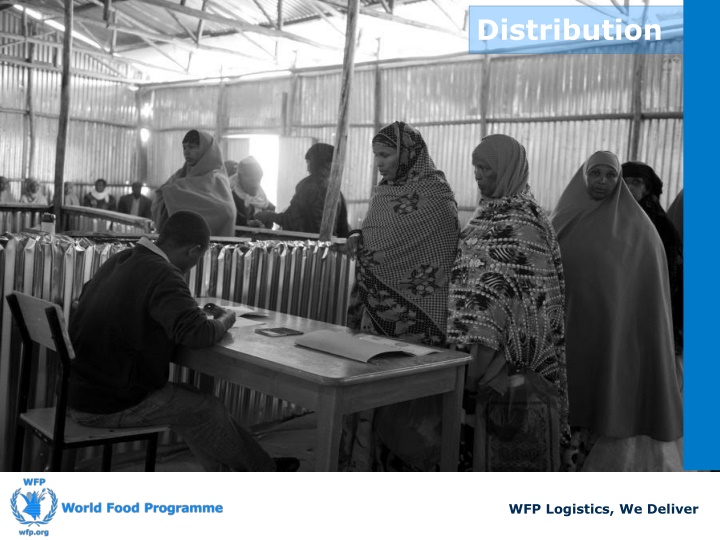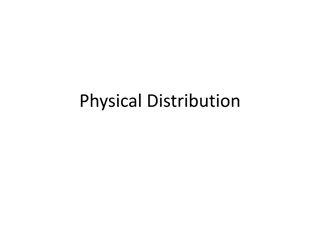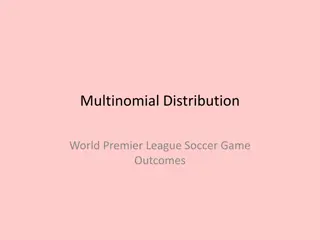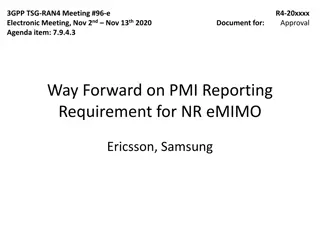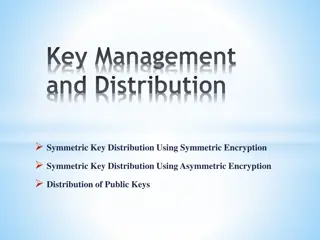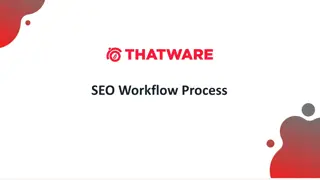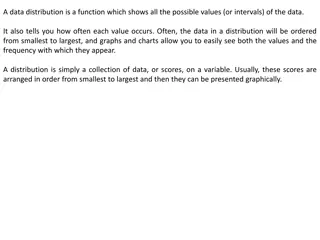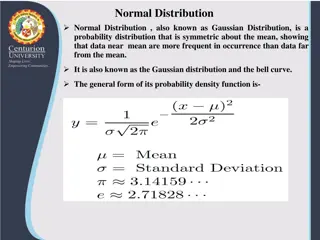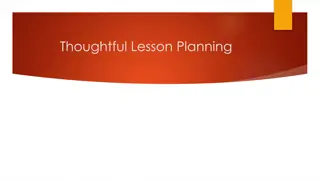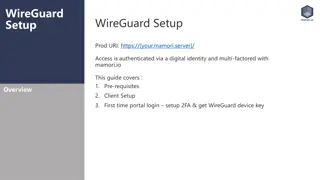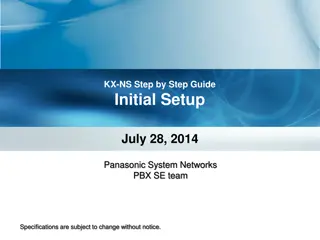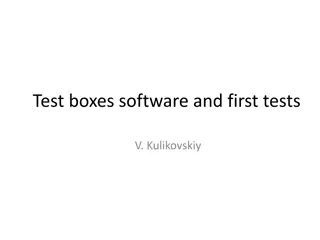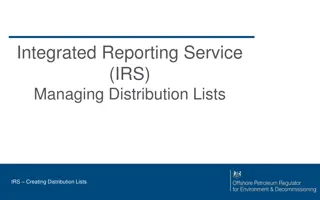Comprehensive Lesson on Distribution Planning and Setup
This detailed lesson plan covers essential aspects of distribution systems, planning, setups, layouts, and actors involved in the distribution cycle. Participants will learn about distribution types, considerations, and evaluation criteria to ensure successful distribution operations. The session includes interactive exercises, discussions on distribution layouts, and insights into various actors' roles in the distribution process, enhancing participants' understanding of efficient distribution practices.
Download Presentation

Please find below an Image/Link to download the presentation.
The content on the website is provided AS IS for your information and personal use only. It may not be sold, licensed, or shared on other websites without obtaining consent from the author.If you encounter any issues during the download, it is possible that the publisher has removed the file from their server.
You are allowed to download the files provided on this website for personal or commercial use, subject to the condition that they are used lawfully. All files are the property of their respective owners.
The content on the website is provided AS IS for your information and personal use only. It may not be sold, licensed, or shared on other websites without obtaining consent from the author.
E N D
Presentation Transcript
Distribution WFP Logistics, We Deliver
Lesson Plan: Distribution LEARNING OBJECTIVES: By the end of the session, participants will be able to: Describe the distribution system types, selection criteria and cost implications Describe the considerations for distribution planning and setup Describe the various distribution layouts and actors involved in the distribution cycle Structure Timing Activities Introduction 5 minutes Explain lesson objectives Who to distribute to, distribution types, selecting a distribution system and elements and cost implications for distribution Distribution Systems 10 minutes Outline the planning process, frequency, considerations, resource requirements, and coordination of preparing for a distribution Distribution Planning 10 minutes Setting up and Conducting a Distribution Outline the design of the layout of the site to setting up the site, registration of beneficiaries, security considerations and post distribution activities 10 minutes Exercise: Distribution Planning 30 minutes In Groups, define important considerations in each phase for preparing a distribution Discuss the various types of distribution layouts (single flow, multiple flow, segregated flow) pros and cons for each and reasons for selecting each type Distribution Layouts 10 minutes Actors involved throughout the Distribution Process Outline the various actors (beneficiaries, community leaders, NGO, INGO, RCRC), and interactions and what to expect from them in a distribution 10 minutes EVALUATION / RECAP QUESTIONS: The facilitator should ask the questions below, or similar questions to the class to recap the lesson to ensure participants have understood the lesson content. What are the different types of distributions and when are they used? What are the keys for a successful distribution? What are the 2 main things to control during a distribution? Lesson End/Plenary 5 minutes Total Lesson Length 90 minutes
Lesson Objectives By the end of this lesson, you will be able to: Describe the distribution system types, selection criteria and cost implications 1 Describe the considerations for distribution planning and setup 2 Describe the various distribution layouts and actors involved in the distribution cycle 3
Who Do You Distribute To? Blanket distribution Targeted distribution
Type of Distributions Distribution Type 1: To groups through the group leadership Distribution Type 2: To groups of heads of families Distribution Type 3: To individual beneficiaries or individual heads of families
Selecting a Distribution System Min Max Individual heads of families (Type 3) Level of control by the population Groups of heads of families (Type 2) Resources needed to implement system Groups through the leadership (Type 1) Max Min
Elements of Distribution & Cost Implications Order Processing Costs Customs Handling Costs Storage Costs (Dist Site) Storage Costs External Transport Costs Cost/Value of Goods Internal Transport Costs Shipping Costs Cost of goods Distance/Process Stages
Distribution Set-up Involvement of local stakeholders Beneficiary Involvement Assessment Frequency Registration Method Site & Planning Waiting Area Set-up Flow Stocks Equipment Facilities Supplies Specification Sourcing Lead-time Customs Transport Storage Distribution Plan produced Staffing Security Distribution Reporting and Monitoring
Exercise: Distribution Considerations What you think are the most important considerations for the following: Preparation and planning Arrival and Set-up Registration of beneficiaries Security Layout Discussion
Preparation Planning Preparation & Planning Registration & Distribution Post Layout Security Distribution Type & Frequency Special Considerations Distribution Plan Distribution Schedule Link to Programme Resource Requirements
Preparation Planning Preparation & Planning Registration & Distribution Post Layout Security Distribution Cooperation & Coordination Location Beneficiary Participation Timing Information Sharing Human Resources Stocks, Lists and Spare Capacity Safety & Security
Layout Preparation & Planning Registration & Distribution Post Layout Security Distribution Exit Relief Relief Item 1 Item 3 ID Check Relief Item 2 Waiting Area Storage Zone Registration Enter Call Monitoring Identity Check Beneficiary Flow Security perimeter
Registration & Distribution Preparation & Planning Registration & Distribution Post Layout Security Distribution Family Local leader confirms registration Enters representative registers distribution site Receives ration card Distribution staff call and ID check Family Exits Collects commodities representative signs records distribution site
Security Preparation & Planning Registration & Distribution Post Layout Security Distribution Information & Transparency Staff Management Security Monitoring Crowd Control
Post Distribution Preparation & Planning Registration & Distribution Post Layout Security Distribution Reverse Logistics Clean Up Post Distribution Monitoring & Evaluation Reporting
Responsibilities Needs assessment Logistics mobilisation plan Programme requirement plan Pipeline report Key Logistics Task Transport goods Programme Task Customs clearance Joint Task Task Local Stock report Distribution Control Receive and warehouse Programme location ID distribution plan Output (Programme or Logistics Requisition Task order Reconcilliation & plan info Delivery Distribution Delivery report Donor / audit report Distribution report
Distribution Layout: Single Flow Relief Relief Item 1 Item 3 Relief Item 2 Storage Zone Call Monitoring Identity Check Beneficiary Flow Security perimeter
Distribution Layout: Multiple Flow Food Items Food Items Storage Zone Food Items Food Items Call Monitoring Identity Check Beneficiary Flow Security perimeter
Distribution Layout: Segregated Basic Facilities Commodities Female Waiting Area Male Waiting Area Commodities Basic Facilities Call Monitoring Identity Check Beneficiary Flow Security perimeter
Actors Throughout the Distribution Process Community leaders & members Local Authorities UN agencies Local NGO s International NGO s
Lesson Recap Questions: What are the distribution system types, their selection criteria and the cost implications? 1 What are the considerations for distribution planning and setup? 2 What are the various distribution layouts and actors involved in the distribution cycle? 3
Questions WFP Logistics, We Deliver
